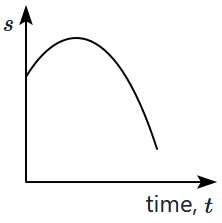| 1. | is constant in magnitude only |
| 2. | is constant in direction |
| 3. | is constant in magnitude and direction |
| 4. | varies, both in magnitude and direction |

To unlock all the explanations of this course, you need to be enrolled.

To unlock all the explanations of this course, you need to be enrolled.
| (A) | distance travelled by \(A\) = distance travelled by \(B\) |
| (B) | acceleration time of \(A\) = \(\dfrac12\) acceleration time of \(B\) |
| (C) | relative velocity of \(A\) with respect to \(B\) is always positive |
| (D) | deceleration time of \(A\) = \(2×\) deceleration time of \(B\) |
Choose the correct option from the given ones:
| 1. | (A) is True. |
| 2. | (A), (B) are True. |
| 3. | (A), (B), (C) are True. |
| 4. | (B), (C), (D) are True. |

To unlock all the explanations of this course, you need to be enrolled.

To unlock all the explanations of this course, you need to be enrolled.

| 1. | \(1~\text{m/s}\) along the positive \(x\)-axis |
| 2. | \(1~\text{m/s}\) along the negative \(x\)-axis |
| 3. | \(\dfrac{1}{\sqrt2} ~\text{m/s}\) along the positive \(x\)-axis |
| 4. | \(\dfrac{1}{\sqrt2}~\text{m/s}\) along the negative \(x\)-axis |

To unlock all the explanations of this course, you need to be enrolled.

To unlock all the explanations of this course, you need to be enrolled.
A man driving a scooter at \(15~\text{m/s}\) brakes at the rate of \(2~\text{m/s}^2\). His speed, after \(10~\text{s}\) after the application of brakes will be:
1. \(5~\text{m/s}\)
2. \(-5~\text{m/s}\)
3. \(0~\text{m/s}\)
4. \(10~\text{m/s}\)

To unlock all the explanations of this course, you need to be enrolled.

To unlock all the explanations of this course, you need to be enrolled.

1. \(10~\text{m}\)
2. \(15~\text{m}\)
3. \(20~\text{m}\)
4. \(25~\text{m}\)

To unlock all the explanations of this course, you need to be enrolled.

To unlock all the explanations of this course, you need to be enrolled.
A boy throws a ball straight up the side of a building and receives it after \(4~\text s.\) On the other hand, if he throws it so that it strikes a ledge on its way up, it returns to him after \(3~\text s.\) The ledge is at a distance \(d\) below the highest point, where \(d=? \) (take acceleration due to gravity, \(g=10~\text{ms}^{-2})\)
1. \(5~\text m\)
2. \(2.5~\text m\)
3. \(1.25~\text m\)
4. \(10~\text m\)

To unlock all the explanations of this course, you need to be enrolled.

To unlock all the explanations of this course, you need to be enrolled.

| 1. | \(1~\text{ms}^{-1}\) | 2. | \(2~\text{ms}^{-1}\) m/s |
| 3. | less than \(1~\text{ms}^{-1}\) | 4. | greater than \(2~\text{ms}^{-1}\) |

To unlock all the explanations of this course, you need to be enrolled.

To unlock all the explanations of this course, you need to be enrolled.
where the units are in SI. The acceleration of the balloon is:
1. zero
2. \(10~\text{ms}^{-2}\) to right
3. \(5~\text{ms}^{-2}\) to right
4. \(10~\text{ms}^{-2}\) upward

To unlock all the explanations of this course, you need to be enrolled.

To unlock all the explanations of this course, you need to be enrolled.
1. \(d_2 = d_1\)
2. \(d_2 = 2d_1\)
3. \(d_2 = 3d_1\)
4. \(d_2 = 4 d_1\)

To unlock all the explanations of this course, you need to be enrolled.

To unlock all the explanations of this course, you need to be enrolled.

| Column-I | Column-II | ||
| \(\mathrm{(A)}\) | \(a_{\Large_A}=a_{\Large_B}\neq 0\) | \(\mathrm{(I)}\) |  |
| \(\mathrm{(B)}\) | \(a_{\Large_A}>a_{\Large_B},u_{\Large_A}<u_{\Large_B}\) | \(\mathrm{(II)}\) |  |
| \(\mathrm{(C)}\) | \(a_{\Large_A}<a_{\Large_B},u_{\Large_A}=u_{\Large_B}\) | \(\mathrm{(III)}\) |  |
| \(\mathrm{(D)}\) | \(a_{\Large_A}<a_{\Large_B},u_{\Large_A}<u_{\Large_B}\) | \(\mathrm{(IV)}\) |  |
| 1. | \(\mathrm{A\text-II,B\text-I,C\text-IV,D\text-III}\) | 2. | \(\mathrm{A\text-III,B\text-IV,C\text-II,D\text-I}\) |
| 3. | \(\mathrm{A\text-II,B\text-IV,C\text-III,D\text-I}\) | 4. | \(\mathrm{A\text-III,B\text-I,C\text-II,D\text-IV}\) |

To unlock all the explanations of this course, you need to be enrolled.

To unlock all the explanations of this course, you need to be enrolled.






